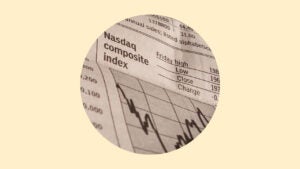What is the P/E ratio and how is it used?

The price-to-earnings, or P/E, ratio is one of the most common financial ratios used by investors to evaluate stocks. The simple ratio is fairly easy to calculate and understand and may help you identify undervalued stocks to buy. Here’s what to know about the P/E ratio.
What is the P/E ratio and how is it calculated?
The P/E ratio is a simple way for investors to compare what they are paying for a stock (price) to what they’re getting (earnings). The P/E ratio is calculated by dividing a company’s stock price by its earnings per share. For example, if a $20 stock had $2.00 per share in earnings, its P/E ratio would be 10 ($20/$2.00).
Trailing P/E ratio
You can use different earnings measures when calculating the P/E ratio. The trailing P/E ratio uses earnings per share over the previous 12 months. The advantage of using trailing earnings is that there aren’t forecasts involved – you know what they earned because the company has already reported it. However, a company that’s growing its earnings at a high rate may appear to have a high P/E multiple if you only use trailing earnings in your calculation.
Forward P/E ratio
Conversely, you can also use a forecast of future earnings to calculate the P/E ratio. This involves using projected earnings per share for the coming 12 months. This approach can be useful for fast growing companies or for companies that may have had one-time challenges over the prior year, which might distort the trailing P/E ratio. However, if your forecasts about the future are off, the forward P/E ratio will not be very useful in your analysis.
P/E ratio investing strategies
The P/E ratio is a valuation metric that investors use to gauge whether a stock may be undervalued or overvalued. All else being equal, it’s better to pay a lower multiple of earnings than a high one, but it’s never that simple of an analysis.
The P/E ratio that the market assigns to a stock takes into account lots of different factors about the underlying business such as its growth rate, profitability, stability and the market’s confidence in a business’ future growth.
Value investors often look for stocks trading at low P/E ratios because they think it may indicate that a company is undervalued. Growth investors, on the other hand, are often willing to pay higher P/E multiples for companies that are growing at high rates.
Legendary investor Warren Buffett has generated enormous returns by investing in undervalued companies. Some of Buffett’s best stock picks ever involved companies trading at low P/E ratios that still had lots of growth ahead of them such as Coca-Cola (KO) and Apple (AAPL).
Disadvantages of P/E ratio analysis
The P/E ratio is one of the simpler tools to use when it comes to stock analysis, but there are some drawbacks to be aware of.
- Earnings can be foggy: Companies often have ways to manipulate their earnings per share through various accounting decisions and shenanigans. You’ll want to be sure that the number you’re using for earnings is an accurate representation of the business’ true profitability.
- Negative earnings: In recent years, some companies have been able to create lots of value even while reporting negative or very low earnings per share. For example, Amazon (AMZN) reported a loss for years even as it was growing its business and building value. The P/E ratio would not have been a useful tool in valuing Amazon’s business.
- High-growth companies: Companies that are growing earnings at a very high rate may render the P/E ratio useless in terms of stock analysis. Using the trailing earnings figure might always make it seem as if the stock is overpriced and even forecasted earnings can sometimes underestimate a business’s future earnings.
Bottom line
The price-to-earnings (P/E) ratio is one of the simplest tools to use when it comes to stock valuation. It can be a quick way to sift through many companies to identify potentially undervalued stocks before doing more thorough research on the companies. Be sure to understand the number you’re using for earnings per share in your calculation. Earnings can sometimes be manipulated and forecasted earnings don’t always come to fruition.
Why we ask for feedback Your feedback helps us improve our content and services. It takes less than a minute to complete.
Your responses are anonymous and will only be used for improving our website.






